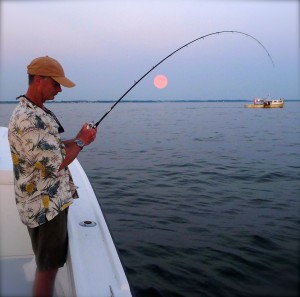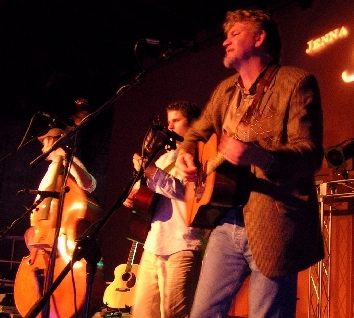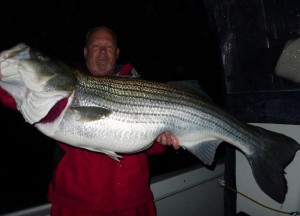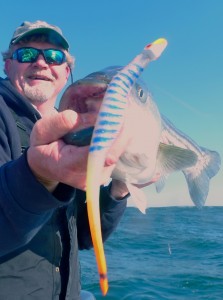strike triggers
 If there is ever a season when it’s necessary to pull out all the stops in order to catch nice striped bass in the Chesapeake Bay, it’s late summer. There are plenty of small fish to be caught, but getting the bigger ones takes a lot more effort. In my presentations this year, I’ve advised fishermen to take what they know about the five reasons why striped bass bite – hunger, reaction, competition, territory, and curiosity – then consider the five senses fish employ when feeding – sight, smell, sound, feel and taste – and fashion their fishing techniques to maximize their chances. In other words, 5 X 5 = success.
If there is ever a season when it’s necessary to pull out all the stops in order to catch nice striped bass in the Chesapeake Bay, it’s late summer. There are plenty of small fish to be caught, but getting the bigger ones takes a lot more effort. In my presentations this year, I’ve advised fishermen to take what they know about the five reasons why striped bass bite – hunger, reaction, competition, territory, and curiosity – then consider the five senses fish employ when feeding – sight, smell, sound, feel and taste – and fashion their fishing techniques to maximize their chances. In other words, 5 X 5 = success.
When fish are hungry and feeding aggressively, they’re easy to catch. Fishermen who are lucky enough to find a school of hunger feeding fish blitzing beneath screaming birds are certain to be successful, no matter what kind of lures they use. Unfortunately, it’s not easy to find bigger fish feeding on the surface this time of year. I’m very envious of the few fishermen I know who have the time and money to chase blitzing rockfish all up and down the East Coast. Since most of us have to go fishing close to home in the limited time we have available, we have to look diligently for the few good stripers that might be around. When we’re lucky enough to find them, we usually have to work hard to convince them to take our lures. Sometimes, they just don’t want to bite. Read More!
 This Friday evening, May 4th at 6:00 PM is the Kent Narrows CCA Banquet and Auction. The event will take place at the Chesapeake Bay Environmental Center in Grasonville, Maryland. I will be singing and playing guitar during the dinner hour accompanied by Mr. Joe Evans from Annapolis. Joe is a well-known fisherman and sports writer and a very talented musician. He’ll be playing banjo, mandolin, and guitar. We will perform a 45 minute set of mostly original tunes. Many of the songs are fishing related including a Chesapeake Bay ghost story written by my son Daniel Kimbro called Cape Charles. You may never see nighttime barge lights on the Bay the same way again!
This Friday evening, May 4th at 6:00 PM is the Kent Narrows CCA Banquet and Auction. The event will take place at the Chesapeake Bay Environmental Center in Grasonville, Maryland. I will be singing and playing guitar during the dinner hour accompanied by Mr. Joe Evans from Annapolis. Joe is a well-known fisherman and sports writer and a very talented musician. He’ll be playing banjo, mandolin, and guitar. We will perform a 45 minute set of mostly original tunes. Many of the songs are fishing related including a Chesapeake Bay ghost story written by my son Daniel Kimbro called Cape Charles. You may never see nighttime barge lights on the Bay the same way again!
Immediately following my set will be a silent and live auction that includes fishing tackle, a kayak, several trips to interesting parts of the world, a beautiful photo of a spotted eagle ray by Jay Fleming, a full-sized signed and personalized poster by award-winning Chesapeake artist Ramon Matheu, and even some honest-to-goodness Appalachian moonshine (with free tasting). Food, beer and wine is included. The event is open to the public. Tickets are available at the door, or you can reserve your spot and pay in advance here: Kent Narrows Banquet.
a beautiful photo of a spotted eagle ray by Jay Fleming, a full-sized signed and personalized poster by award-winning Chesapeake artist Ramon Matheu, and even some honest-to-goodness Appalachian moonshine (with free tasting). Food, beer and wine is included. The event is open to the public. Tickets are available at the door, or you can reserve your spot and pay in advance here: Kent Narrows Banquet.
Next Wednesday evening, May 9th at 7:00 PM I’ll be speaking to the Upper Bay CCA Chapter at the VFW Hall in Northeast, Maryland. I will elaborate on the topics I’ve covered in the latest four-part Strike Triggers series I posted here, and include the latest information about what lures and techniques are triggering strikes right now in the Chesapeake Bay. I also have some updated photos and video included in the hour long power-point presentation.
Hope you can make it to either or both of these fun events!
![0321120733a[1]](http://www.chesapeakelighttackle.com/wp-content/uploads/2012/04/0321120733a1-300x225.jpg) “I only write when I’m inspired,” wrote William Faulkner. I’d find that statement comforting if he hadn’t followed it with, “and I’m inspired every morning at 9:00 AM.” Lately, my every-morning-at-9:00 AM-ritual hasn’t included much writing. Oh, I’ve had plenty to write about, it’s just that I’ve over-committed myself (again) so that every spare waking minute seems filled with obligation. When I have a spare hour, I usually go fishing. Since I bet you’d much rather hear about the fishing than the excuses, I’ll dive right in.
“I only write when I’m inspired,” wrote William Faulkner. I’d find that statement comforting if he hadn’t followed it with, “and I’m inspired every morning at 9:00 AM.” Lately, my every-morning-at-9:00 AM-ritual hasn’t included much writing. Oh, I’ve had plenty to write about, it’s just that I’ve over-committed myself (again) so that every spare waking minute seems filled with obligation. When I have a spare hour, I usually go fishing. Since I bet you’d much rather hear about the fishing than the excuses, I’ll dive right in.
There’s nothing more inspiring than a big fish. That’s Uncle Phill Anderson in the cover shot holding up a nice light-tackle fish he jigged up on a recent foggy morning in the mid-Bay. (Shhh, don’t tell the meat-fleet we’re picking off fish of this class with light tackle. It might catch on!) When I left off a month ago, I was smack in the middle of a series about strike triggers. I’m discussing why striped bass attack a lure, and how they are attracted to their prey. As previously mentioned, almost any lure or technique will work on hunger-feeding fish. Unfortunately, most of us don’t have the time or resources to always go fishing at the places where hungry fish are most abundant. We have to fish in the limited time we have available, and usually very close to home. While we may occasionally encounter groups of ravenous fish, most of the stripers in our neighborhoods are pretty hard to catch. In order to be consistently successful, we have to provoke strikes from fish that may not be inclined to bite by appealing to their five senses. I’ve written about sight, sound, and feel. This entry completes the strike triggers series with a look at smell and taste. Read More!
 The third in a series of entries about the senses striped bass use to find their prey, here’s a look at how we can trigger more strikes by understanding how stripers hear and feel. It’s no secret that fish can be either attracted or repelled by sound. One of the biggest mistakes I see from rookie Chesapeake Bay fishermen is making too much noise. Every hunter knows the importance of stealth. When I was a kid, my dad taught me to walk lightly in the woods and to avoid stepping on sticks or limbs that might crack. He also showed me how to control a cough or sneeze and advised me to regulate my breathing in order to be more stealthy. Later, I sat through U. S. Army basic training and NCO academy classes stressing the importance of noise discipline in combat. Avoiding excessive noise when you’re fishing seems like common sense, but I’m always amazed when I see a boatload of fishermen roar up on a fishing spot, laughing and shouting with radio blaring and engine running.
The third in a series of entries about the senses striped bass use to find their prey, here’s a look at how we can trigger more strikes by understanding how stripers hear and feel. It’s no secret that fish can be either attracted or repelled by sound. One of the biggest mistakes I see from rookie Chesapeake Bay fishermen is making too much noise. Every hunter knows the importance of stealth. When I was a kid, my dad taught me to walk lightly in the woods and to avoid stepping on sticks or limbs that might crack. He also showed me how to control a cough or sneeze and advised me to regulate my breathing in order to be more stealthy. Later, I sat through U. S. Army basic training and NCO academy classes stressing the importance of noise discipline in combat. Avoiding excessive noise when you’re fishing seems like common sense, but I’m always amazed when I see a boatload of fishermen roar up on a fishing spot, laughing and shouting with radio blaring and engine running.
Obviously, stripers can be put off by noise, but they can be attracted by the sounds they’ve learned to associate with food. To a casual observer, it might seem like a quiet world beneath the water, but it’s really a noisy environment: Drumfish drum, croakers croak, baitfish bolt, crustaceans click, even crawling crabs contribute to the convoluted cacophony of sound. Striped bass hear low-pitched subaquatic sounds better than humans. They have an auditory range that starts on the low end at 15 sound waves per second (Hz) and tops out on the high side at about 15,000 Hz. Humans can’t hear sounds much lower than 20 Hz, but we can usually hear high pitched sounds better than rockfish. The angler’s challenge is to amplify the sounds that trigger strikes, while masking the ones that send fish packing. Read More!
 Along with sneaking in a couple of catch-and-release fishing trips, I’ve been reading all I can lately about why we catch fish with ease on some days, and why we cant buy a bite at other times. I can’t say I’ve solved that mystery, but I’ve included most of the knowledge I’ve gained in a PowerPoint slide show that I will present over the next couple of months to area fishing clubs. If you attended the Annapolis Saltwater Fishing Expo last weekend, you’ve already seen this show, but don’t be surprised if it morphs into a somewhat different format as I present it to different groups and organizations. I learn more every time I talk to fellow fishermen, pick up a book, read a magazine article, look at a website, and (especially) when I go fishing. Here’s a sneak preview of my Strike Triggers presentation:
Along with sneaking in a couple of catch-and-release fishing trips, I’ve been reading all I can lately about why we catch fish with ease on some days, and why we cant buy a bite at other times. I can’t say I’ve solved that mystery, but I’ve included most of the knowledge I’ve gained in a PowerPoint slide show that I will present over the next couple of months to area fishing clubs. If you attended the Annapolis Saltwater Fishing Expo last weekend, you’ve already seen this show, but don’t be surprised if it morphs into a somewhat different format as I present it to different groups and organizations. I learn more every time I talk to fellow fishermen, pick up a book, read a magazine article, look at a website, and (especially) when I go fishing. Here’s a sneak preview of my Strike Triggers presentation:
Have you noticed that some fishermen seem to steadily catch big fish and regularly have successful days even when others don’t? What are they doing differently? In my opinion, one trait of consistently productive fishermen is an appreciation for the concept of strike triggers. They may not always call it that, but you can pretty well bet that good fishermen are incorporating techniques in their lures and lure presentations that trick fish into biting even when they’re not particularly inclined to eat. It starts with a good understanding of the five reasons why striped bass attack a lure. Read More!


